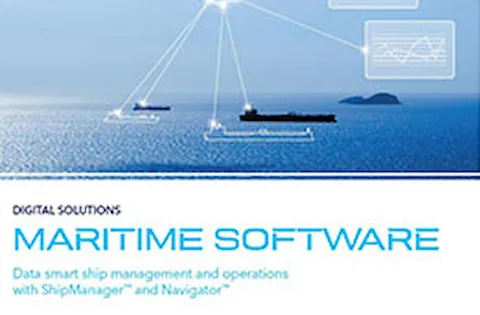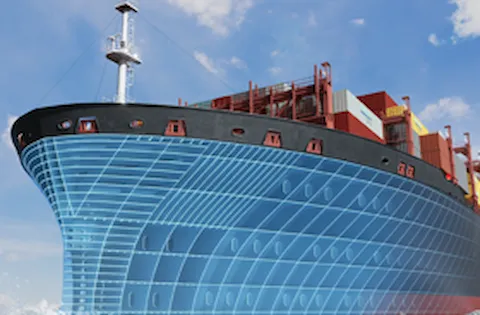Is your crew prepared for hull inspections?
Ship owners are dependent on reliable and user-friendly systems for hull integrity management, but just as important is proper knowledge about the ship's hull among crew.
If you don't know what to look for, where to look and how to evaluate what you see for during a hull inspection, the value of the inspection may be limited.
Tank inspections
Ship owners are in need of qualified and experienced personnel for carrying out proper tank inspections. There is a need for better planning of maintenance as well as for improved documentation of hull condition for external parties.
Surface area of hull inspections
The challenges facing inspectors are numerous. For example, take the enormous area that must be inspected on a double hull VLCC oil tanker. The area of just one fore peak tank or one side water ballast tank is approximately comparable with the area of two international football (soccer) fields. The area of the tanks of a complete VLCC is comparable with approximately 32 football fields. It is of course a challenge to cover all this during an inspection due to limited time, so it’s essential to know where and what to look for. The understanding of the flow of forces in the structure to identify hot spots is also essential, as well as understanding the consequences of damage now or in the near future, including the impact this will have on your business. In order for the crew to carry out the inspections, they must be properly trained.
In DNV’s hull structure courses, many different areas of hull inspection are covered. Where should I look and what should I look for? Is the coating good, fair or poor? Where am I likely to find cracks? How are the loads taken up by the structure? What is the consequence of a crack in this detail? How do I report this damage?
This knowledge will improve the quality of your inspections, allowing you to carry them out more efficiently and evaluate hull damage when you see it. Learning more about hull inspection will also allow you to organize uniform hull inspections throughout your fleet that give consistent reporting of the condition and findings. These inspections will facilitate onshore decision-making based on improved knowledge of the condition of your fleet.
“Hot spots”
When the crew is able to pay special attention to “hot spots” and historical findings from sister vessels prior to an inspection, the likelihood of focusing on the right areas increases significantly. The latest developments of ShipManager Hull includes these features. The crew and onshore staff can define and visualize “hot spots” in the model. Findings on a vessel can also be visualized in models of the sister vessels, which enables the crew to perform more targeted special ship inspections for follow-up. The results from thickness measurements (UTM) can also be visualized both onboard and onshore to provide more input for the inspectors.
Training using 3D simulation
With the technological advances in the industry, crew training may not incur as many costs today as it would have just a few years ago.
Inspection skills and technical assessments for ship surveyors still require a long and thorough training process in order to prepare for the variety of conditions they will experience. Such a learning process may take years. Each trainee must be supervised by an experienced colleague, a tutor. It can at times be very difficult to find a sufficient number of good tutors to train surveyors in the traditional way. Training in the traditional way is also dependent on access to vessels of a certain type at a specific time and location. For example, to get training on specific ship type the trainee must be physically present, which normally involves high travel costs. Even if a vessel is scheduled for survey it is not known at the outset if there are any deficiencies or findings, which would have been valuable from the learning point of view. No one can foresee what will be observed during survey or inspection, but some problems are more common than others. Some damages are typical for a certain type of vessels of specific age. On the other hand, there are also defects that are extremely rare, only occurring under very specific circumstances. An individual surveyor may not ever see such a case in their entire working career, making it highly unlikely that a trainee will ever see such a case during hands-on training.
This is where the advantages of new teaching methods are seen. DNV’s Survey Simulator software is one such new method. The Survey Simulator is a photorealistic 3D training environment that helps teach the staff of owners and operators how to carry out technical inspections. It assists ship operators in improving and measuring their staff competencies in order to achieve incident-free operations and high standards of technical ship management.
Survey Simulator training scenarios
The Survey Simulator was created to introduce young surveyors to their work and make the learning process more efficient, attractive, practical and less costly. However, there are many other areas where the tool can be successfully used. The training scenarios are based on very realistic models, which can be ship-specific, where high quality and attention to every detail allows the trainee to identify with the inspector role. It creates the possibility to simulate many types of inspections.
It can for example provide a solution for use for professionals who need to know everything about the vessel before they step on board. The simulator can also establish an interactive collaboration workspace for individuals working upon the same problem at a distance – enabling them to meet ‘on board’ the ship in a shared virtual reality. Providing a new way of presenting the hull and pinpointing important spots, the simulator can help to remove language, space or experience barriers. It is an excellent solution for use during experience exchange seminars. Surveyors at different locations across the world can run selected training scenarios and discuss how to properly handle difficult problems in presented cases.
Not only typical damages, but also rare ones, can easily be transferred to the virtual models and included in training scenarios.
Survey Simulator overcomes such obstacles as lack of vessels (or installations) to survey, lack of training examples, lack of time to perform the training on the available vessel and difficult access.
The supplemental ship surveyor training with Survey Simulator software is carried out in an ideal environment. Trainees have the possibility to use different virtual tools such as torch, spray, camera, palmtop, computer etc. The Survey Simulator has an option of prompting built-in knowledge. Several options available allow adapting training scenarios to the level of a trainee. Also there is a possibility for selection and visualization of various vessel parameters, such as age, coating condition, level of difficulty, survey scope, etc.
A proactive approach to hull management (inspection/condition monitoring, maintenance and repairs) is important to be in control and manage the risk of unforeseen repairs. There are opportunities for significant savings on technical operating costs and TCO by implementing a management system focusing on hull inspection and maintenance, while building internal expertise, attending courses and also utilizing a unique virtual reality ship inspection training tool.
Contact:
Stefan Fröbe, Marketing and Communication Manager Ship Product Line



